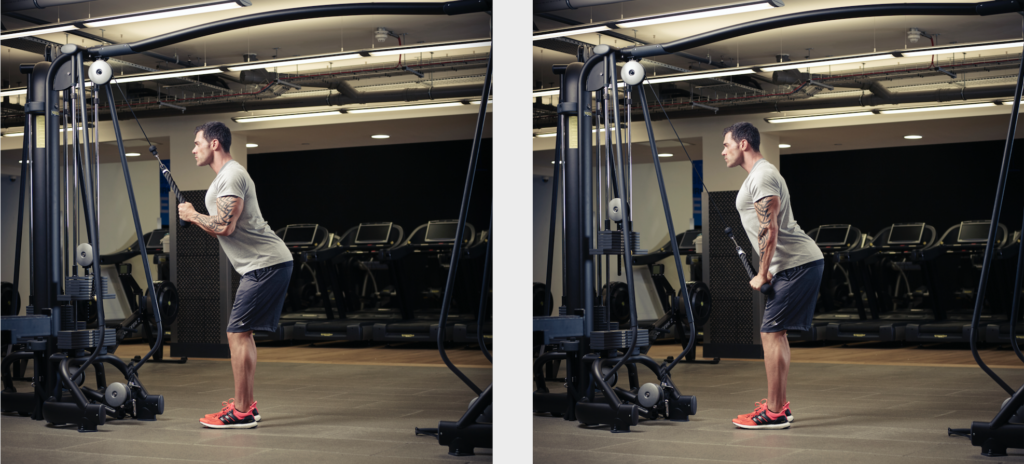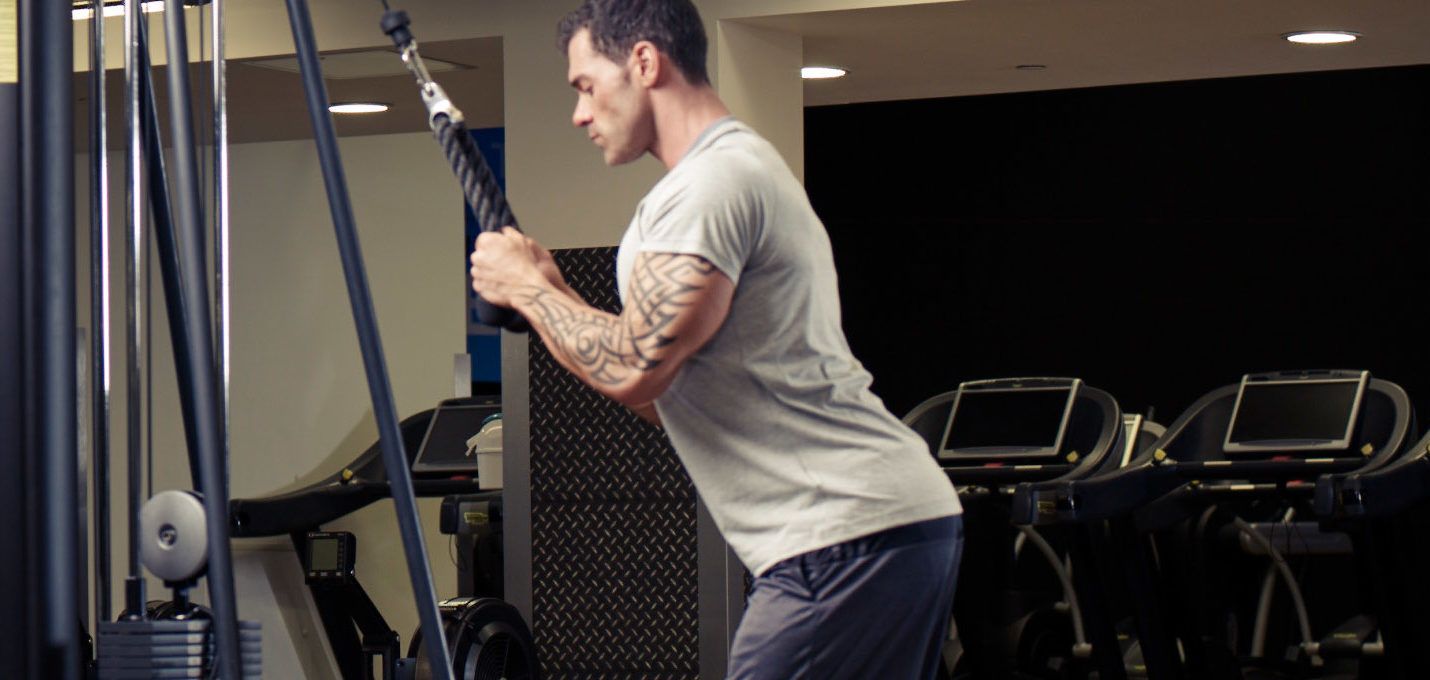Use the rope pressdown to get big, strong and defined arms
The tricep rope pressdown is one of the most popular gym moves for bigger arms. But, like so many upper-body lifts, many people do the move badly and so never make the size or strength gains they want. Here’s how to nail this important exercise to rapidly build bigger, stronger and more defined arms, says New Body Plan fitness editor Joe Warner
In the pursuit of bigger arms most people fall into the trap of dedicating more gym time to their biceps – doing most moves on the list of the best bicep curl exercises – at the expense of their triceps.
Why? Because their biceps are the muscles they can see more clearly in the mirror, whilst the triceps hide away on the back of the arms. But the best way to add serious arm size quickly is to spend quality training time on the triceps.
Building more muscle mass on the back of your upper arms will transform how you look in a short-sleeved t-shirt. And there’s few better gym moves for packing on triceps size than the cable tricep rope pressdown. But you need to do it right to build bigger, stronger and more defined muscles. Here’s what you need to know to make the rapid gains you want!
What is the cable tricep rope pressdown?
The cable tricep rope pressdown (also known as the cable tricep pushdown) is an isolation (single-joint) exercise that you perform using a cable machine. You’d typically perform it while standing upright with the cable set at the highest point on the machine.
What muscles does the rope pressdown work?
Take a guess. That’s right! The rope pressdown works the triceps. It’s an isolation move. That means if you’re doing it properly then no other muscle groups meaningfully get in on the act. If you do feel it in other muscle groups, then it’s worth checking your form against our guide below to make sure you’re doing it the right way. Not only does perfect form mean you’ll build bigger arms faster, it also safeguards against injury.
How to do the cable tricep rope pressdown

• Stand facing a cable machine and set the pin at the top.
• Add your attachment of choice. In this instance we’ll use the rope attachment to achieve the greatest range of motion (see below for other handle attachment options).
• Start with your upper arms by your sides and your elbows tight to your body with tension in the cable.
• Lean forwards from the hips slightly so that the angle of the cable is roughly in line with your body.
• Keeping your elbows by your sides, press the rope handles down to either sides of your thighs.
• Turn your wrists out slightly for a peak contraction at the bottom of the move and hold for at least a second.
• Return slowly and under control to the start, squeeze your biceps hard, then repeat for the number of reps detailed in your training plan.
What’s the best cable attachment to use for the rope pressdown?
You have a range of attachment options for the cable tricep pressdown. They will all do a similar job but there will be subtle differences. Here are your key tools:
Double-rope cable handle attachment
This is the most challenging, but arguably the most effective, option. The two sides of the rope move independently, so you’ll get balanced muscle growth. The rope also allows for a bigger range of tricep pushdown motion because you can pull then handles either side of your thighs. Turning your wrists out when your arms are straight will give you a great peak contraction.
Straight bar cable handle attachment
This option will allow you to go heavy. You can also use a thumbless grip, which may help you to effectively isolate the triceps.
V-bar cable handle attachment
The angle of this attachment makes it kinder own the elbow joint than the flat bar. So if you get a bit of elbow discomfort when you use the flat bar, this is a good alternative.
Should I do the cable tricep rope pressdown?
That depends on your goals and training frequency. Generally speaking, if you’re only training 2-3 times a week, then it’s not the most effective use of your training time. You’d probably be better off doing more compound exercises that also work your triceps. Examples include dips and the close-grip bench press.
And if strength, rather than aesthetics is your goal, it may also be of limited use. But strength athletes may still use it tactically to iron out weak points. If you’re training to maximise muscle size and you’re doing at least four sessions a week, it’s a perfectly valid exercise.
How do to the cable face pull for strong and stable shoulders
What are the best cable tricep rope pressdown alternative exercises?
Training at home and you don’t have access to a cable machine? You can still perform the movement. You’d need to use a resistance band of some kind. Some bands can be wedged in a door frame. Others need to be looped over a bar. But the mechanics are the same. You anchor the band up high, set up in the same position as the cable move and pull it down until your arms are straight.
If you’re using an outdoor gym or you want a more functional option, the triceps dip can work well. It is a tough move but you can still use it even if you can’t do a full rep. Start by doing slow eccentrics (you do the lowering phase as slow as possible) and build up from there.
Burn fat and lose your belly with the best cardio for weight loss
How to get better at the rope pressdown
Lock-in your elbows
Before you start your set take a moment to “fix” your elbows to either side of your ribs. Much like when doing a biceps curl you don’t want your elbows to flare out to sides, nor move forwards or backwards, during a rep because this means momentum is getting in on the act and so reducing the workload on your triceps. If you can’t do a rep without your elbows moving the weight is too heavy so reduce the resistance and go again.
Pause to flex your triceps
Press your hands down and take each rope handle to either side of your thighs then fully straighten your arms and flex your triceps hard. Pause for at least one second so that more muscle fibres are activated to hold this position, because the more fibres you recruit the greater gains you’ll make. Be careful not to round your shoulders or change your torso position at all as you press your hands down: the only parts of your body that should move are your forearms.
Move through a full range of motion
Slowly return your hands back up to the start position – around two seconds is a good target – to once more force as many muscle fibres as possible into action to move and manage the weight. Once back at the top, when your hands are closest to your chin, squeeze your biceps muscles hard. Doing this at the top, then flexing your triceps at the bottom, means the working muscles will move through a full range of motion for every rep, and that’s a big factor behind size and strength increases.
Avoid the most common cable rope pressdown mistakes
Too much upper arm movement
Technically speaking, when you’re doing a rope pressdown, any upper arm movement is too much movement. If you allow your upper arms to come forwards at the start of each rep your back muscles join in. And you’re not doing the tricep pushdown to build a bigger back. So get disciplined and make sure your upper arms stay tight to your sides.
No control for half the rep
This is so common when you look at the average guy doing the tricep pressdown in the gym. They do the first half of the move ok, but then they let gravity take over. They just let the cable return to the start position without maintaining tension on the target muscle. And if you do that, you’re massively missing out on the benefit that you could get from each rep. The fix is simple: return to the start position under control for a count of 3 or 4 seconds.
Using a partial range of motion
If you want to get the full benefit of a tricep pushdown you need to do the full rep. That means straightening your arms at the bottom of the move. And it means getting your hands as high as you can at the start of the move. Just make sure you keep your upper arms still.
Find your perfect fat-loss plan!
Take the New Body quiz!

